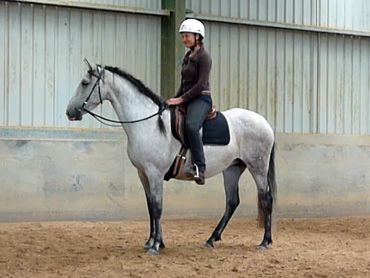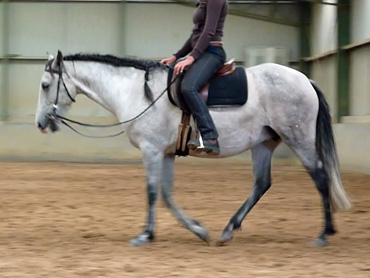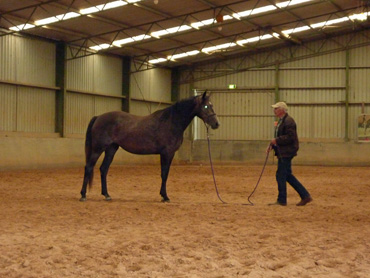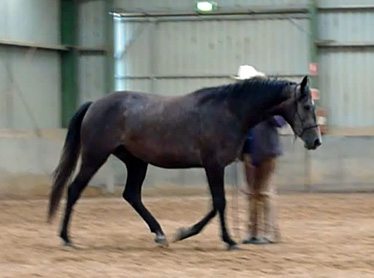AQUILA

... and as I so rode, my heart rang with the grass-hushed steps, rang with the snuffles and bit-play of my Grey, and bliss lit up my heart, and I knew: that if I were to fall out of the world at this moment, I would fall into Heaven. Baron Munchhausen |
News - Harry Whitney Clinic, 16th - 18th January, Geelong |
| Back to Current News |
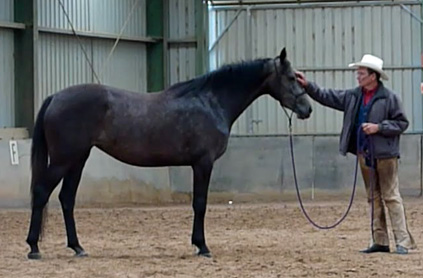 |
From the 16th - 18th of January, 2010, we attended a 'horsemanship' clinic with Harry Whitney at Amber Lodge in Marshall, near Geelong. We were fortunate enough to be able to secure two places and took one of our PRE brood mares, El Caballero Corazona, and a three year old warmblood filly, Lucy AQ. Whilst I have tried to take notes correctly, it is (as always) entirely possible that I have misunderstood or misheard something. I also spent a lot more time at this clinic trying to decipher body language and positioning than taking notes, and it is likely that I have missed several major points of interest. El Caballero Corazona (Cora) was broken in (green broken) when she was rising four, before being put in foal. She has recently been brought back into work after a two year riding break by Johanna Engelhardt, a German rider who is working with us for several months. At the time of the clinic, Cora had been ridden by Jo approximately six times.
Lucy AQ is an extremely smart, courageous and strong willed warmblood mare, bred by us. She was taught to lead and handled as a foal, but since that time she has been growing up in the paddock (only being handled for feet, worming, vaccinations etc). She was loaded on a float for the first time the day before the clinic , and the first day of the clinic was also her first day off the farm. Whilst Lucy is very willing to please those that she 'likes' - Tony (in whom she appears besotted) and Sarah - she is not an 'easy mare'.
There was a lovely group of horses and riders at the clinic, and the riders were all wanting to work on different issues. One horse in particular, a Clydesdale-Paint cross, appeared to be quite troubled and looked to have been quite harshly treated at some point in the past. The difference in this mare by the end of the clinic was quite dramatic. Our group split our six lessons: Jo worked with Cora twice, and Sarah and Tony with Lucy twice each. On the first day, a lot of time was spent in doing ground work. One of the first things Harry spoke about was trying to change the horses thoughts. Making a noise by slapping a hand on the thigh, or a rope on boots, gets a reaction from a horse. This is not used to scare a horse, but rather to let the horse know that the 'direction' that the horses thoughts are taking 'is not working'. For example, a horse might be thinking about moving to the door - slap your thigh, and the horse will bring its attention to the handler. Harry said that if you watch your horse closely enough, you should be able to stop an action from occuring - that is, you stop the thought. By stopping the thought, you have as good as told the horse that the action itself would not work, and it often happens that a horse won't try the same trick again. The horses were expected to walk forward and backwards to light pressure, stopping when the handler stopped (or asked them to stop). They were also expected to step over with their shoulder, or hind quarter - moving to the side, not forwards or backwards. The were also asked to walk around the handler - handlers were asked to put the horse's attention in a particular direction, and then ask the horse to move off in that direction. If a horse barged in towards the handler, then the horse was asked to step over at the shoulder and move out. Horses should react as well when the handler is in front of them (and the horse has something to follow) as when the handler walks beside the horse with his hand on the horse's withers (e.g. the handler is behind the shoulder in the approximate position he would be in the saddle). Handlers were informed not to move out of the horse's way - the horse needed to move out of the handler's way. Handlers should also not stand too close to the horse - they can be more effective with a longer rope When you go up to pat the horse on the head, watch what he does. If he sticks his nose out to you and is interested, that is good. If he sticks his nose out to bump you (and keep track of you) whilst he is looking elsewhere, bump his nose gently to get his attention before patting him. Harry believes that we can sometimes make doing the wroing thing so bad, that the horse eventually gives up trying to do the right thing. He also commented several times that it is important not to do things so often, or so repetitively, that you annoy the horse. Ask for something, make sure you get it, and then move on to something else. Horses are gamblers by nature. If they got some reward once, they will try for it again and again and again, on the chance that they will get that reward on the next try. Just like a gambler pulling the lever on a slot machine. It appeared to me over the three days that when Harry wanted a horse to get used to something (e.g. putting on a saddle blanket, or jumping up and down next to a horse) then he would continue with what he was doing until the horse accepted that what was being done would not hurt the horse, and was not a cause of concern. He was also very concerned with clarity. Handlers and riders should be very clear in what they are asking, to give the horse every chance to understand. The horse had 'primary' and 'secondary' thoughts. He can do what you are asking him whilst his thoughts are occupied elsewhere. However, we want thim to concentrate on what you are asking him with his primary thoughts, and have his secondary thoughts occupied with his surroundings. Ask the horse to think in a particular direction, and pretty soon his feet will follow. Horses were asked to think in a particular direction by pointing in a direction. If the horse didn't look, then Harry would point his finger at the horse in a tapping motion (not quite touching the horses head), effectively pushing the head in the direction he wanted the horse to look. If that wasn't enough, then he would gently tap the horse on the side of the head until it looked to the side - and shifted its attention in that direction. If the horse was still resistant, the handler could move away from where the horse was wanting to look, forcing the horse to make a decision between looking at you, or looking at what he wanted to look at. Invariably, the horses turned to look at the handler. The horses were sometimes asked to step their hind quarters over whilst under saddle. This was an interesting movement, and reminded me a little of the slow shoulder-in at the walk that Gerd Heuschmann uses of to relax a horse and promote chewing & relaxation of the jaw. Ask with one rein. If he falls on the forehand, back him up. He will rebalance and then you can ask again. Therefore, stepping over is almost like a backwards motion. When the horse understands what you are asking, use your leg to ask him to step over - but not before. Don't use your leg too soon, and you need to ensure that your horse understands forward. Eventually, you will just use your leg. When a horse halts, he will often halt balanced and then shift his weight forward onto the fore quarter. Use the reins to ask him to shift his weight back - just enough so that the horse balances back onto the hind quarter a bit more. Drop the reins at the halt. If you pick them up, the horse should be ready to move his feet - to back up, to bend, to do something. Harry demonstrated on one of the horses, asking for particular legs to be moved, not just 'any' leg to be moved. This appeared to demonstrate great precision in his aids. A horse can't separate what he is doing from how he is feeling. Give him a purpose! Walk with a purpose - like you are going somewhere and really want to get there. This will help you to get the horse with you.
On the last day, one of the participants kindly gave up her lesson to allow a friend to bring her lovely stallion. The stallion is very well behaved, but the owner doesn't think that she has his full attention when she takes him off her property and away from his mares. The owner wanted to work on making sure she had the horse's attention. The lesson went as follows: Ask the horse to look to the left and to the right - but not to move his feet. Ask him to back up, and get him to wait for you. Make sure you keep his attention on you - if he looks to the side, or out the door, bring him back to you. Ask him to look to the sides again - direct his thoughts. Stand in front of him and ask him to move his head to the left or the right. Then, step to one side - you want the horse the shift his head to keep facing you as you move. But as you haven't asked him to move his feet, he should stand still. Walk back - draw him to you. Get him to stop when you stop (as soon as you stop). Ask him to back up. If his attention wanders, slap your hand on your thigh to bring him back to you. Walk back - extend the lead, but don't ask him to come forward. He should stand still. Then ask him to follow you. He should stay centered on the line if his attention is on you. At the halt, the horse 'fell forward' onto its front. Ask him to shift his weight back (via the lead) to discourage the tendancy to come into you. Now, ask him to look in a direction - his mind, not his feet. Then ask him to move his feed and walk around you in that direction. Ask him to step his shoulder over. Direct his thoughts left. Ask him to move left by stepping the shoulder over, not by coming forward towards you. Walk to the horse and ask him to step back and over - away from you. On the circle, make sure he stops when you ask - not later. If we take a break and have the horse standing quietly on a long lead, he can look around him. But you need to make sure that you can get his attention back on you when you want it. Once you know you can get his attention back when ever you want it (i.e. straight away), then you can be a bit more lenient in letting him look around. Step back along the horse and tap his hind quarters. He should still be with you. Get him to walk on with your hand behind the saddle. Direct his thoughts and feet with the lead in your hand. Ask him to stop by vibrating the lead in your hand to get his attention, then stop your feet - he should stop. So, you need to be able to keep his attention when you are walking at the saddle position just as much as when you are in front of him. It is more difficult - the horse can't follow you, but in his head it is the same. In the saddle, you want to look for a light responses. You want a light back up response. Now pick up the left rein - ask for the response. Now the right rein. Change to left again. You want him to turn his front end - his feet will follow his mind. This horse, when asked to go left, will turn his hind quarters around the forehand. This is not what we want - he doesn't like left as much as right. We need to direct his thoughts.
We noticed a dramatic change in Lucy AQ, our young warmblood. This filly can be very bargey, and Harry was able to show us some techniques to deal with this. One of the biggest changes for us was the distance we needed to keep (i.e. the length of the lead rope) in asking her to move back. Harry said that handlers can be more effective at a greater distance, and he seemed to be correct. |
|
|
. |
. |
